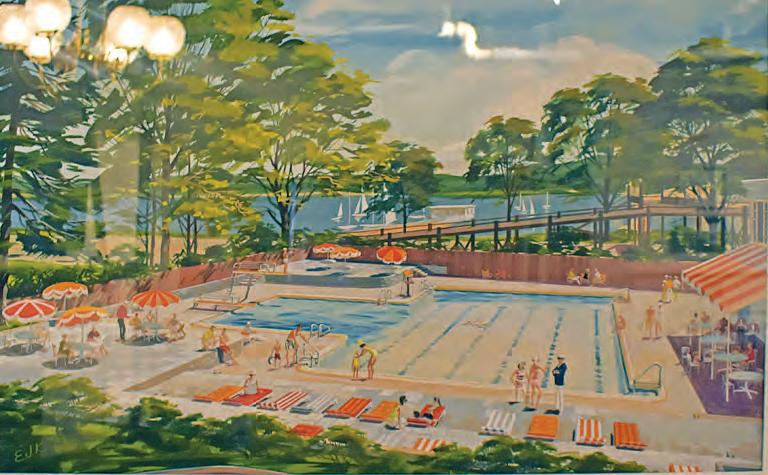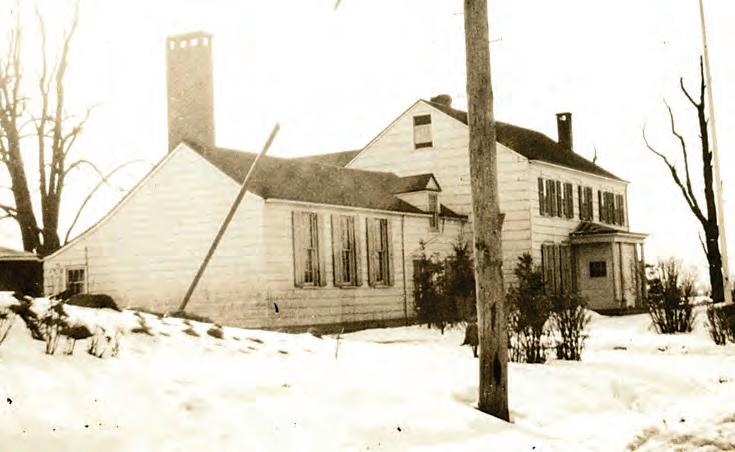
6 minute read
Bayside: Once a playground of the rich
43rd Anniversary Edition Bayside, once a place of leisure
Corner of Queens was filled with estates and golf courses
by Katherine Donlevy
Associate Editor

Bayside has a rich history dating back thousands of years.
It was the home to the Matinecock tribe first and foremost. The Native Americans can date their history on the land back to 2000 B.C., but they were largely massacred and displaced by settlers in the 17th century, spurring the beginning of what we know today as Bayside.
The area was transformed into farmland, and remained that way through the next two centuries and multiple transfers of power: from Dutch to English to American. History swept through the acreage — Fort Totten played a major role in the Revolutionary War, Bayside as a part of Flushing was included as one of the first five towns of Queens — but it remained farmland.
The 19th century marked a turning point for Bayside. Portions of the neighborhood remained fertile growing land, but it slowly became a rural resort for the wealthy. Bayside became a place of leisure.
“The people in Bayside during the late 19th and early 20th century, these are people of means,” said Kara Schlichting, an assistant professor of history at Queens College. “The people who are in Bayside have more in common with the estate communities of Sands Point than the immigrant working class that’s starting to buy very modest homes in Flushing or Rego Park or Kew Gardens.”
To picture this time, Schlichting said, think of “The Great Gatsby.” The Buchanans, Nick Carraway and Gatsby himself were fictionalized versions of the real-life elite who had the luxury of money and time during the Industrial Revolution, Gilded Age and following decades. Excess wealth and time allowed them to travel out to destinations away from the working-class people of the inner city.
Even today, Bayside is comparable to the communities of Nassau County, Schlichting continued, because Great Neck, Manhasset and the rest were all part of Queens until 1898 when they opted to become their own county. Despite being geographically, demographically and economically similar to Bayside, Little Neck and Douglaston, the Nassau towns wanted to remain suburban.
Throughout the 19th and early 20th centuries, estates began cropping up alongside the farms, as well as yacht clubs, country clubs and golf courses, all membership-based organizations associated with the wealthy.
“Bayside used to be a retreat,” said Schlichting. “They’re there for the coast, looking across Little Neck Bay.”
The Great Depression put a stark end to the luxurious century of Bayside, but remnants of the era remained in the following decades, though many of those eventually became obsolete as well.
The Crocheron Hotel once stood at the bottom of 35th Avenue where it dead ends, Paul DiBenedetto, president of the Bayside Historical Society, said. It was once a farmhouse before it was converted into a resort. Before the Cross Island Parkway was wedged onto the coast in the 1930s, it served as a perfect waterfront retreat for celebrities and politicians from 1850 to 1908, when it was tragically destroyed in a fire. The property became city parkland 20 years later. “It was the place to go and hang out, party, have fun and do boating, be in the water,” said DiBenedetto. “People would come from the city and hang out there.”
The Bayside Yacht Club was founded in 1902 at the bottom of 29th Avenue, where the Marina and its footbridge still lie.
The yacht club had originally been a barn, but was remodeled after a fire and expanded to include a clubhouse, dining area, kitchen, bathhouses and more. The original fire was a premonition, and the club suffered a checkered past of hurricanes and murder before it suffered the same fate as the Crocheron Hotel and was destroyed in a 1968 blaze.
There is one institution that shared similar beginnings to the Crocheron Hotel and Bayside Yacht Club, but escaped a tragic ending. What is now the neighborhood of Bayside Hills had once been a golf course.
The Belleclaire Country Club was founded after Manhattanites purchased the 117 acres from the Caine family, who had farmed the land from 1852 to 1917. The farmhouse had stood at the southern end of Bell Avenue near the south side of Rocky Hill Road, or what is now 48th Avenue, near the present entrance to Bayside Hills, and was converted into a golf clubhouse.
“The hills of Belleclaire are why we’re called Bayside Hills,” said Michael Feiner, the president of the Bayside Hills Civic Association. “We are Bayside Hills because of that golf course.”
The neighborhood continues to honor that legacy by maintaining its 33 malls and green spaces, which had once been mowed through the use of hired goats, according to Feiner.
Bayside Hills was once considered part of Bayside — and often is still by the Post Office and Google Maps, an error Feiner continues to correct today — but it became its own neighborhood when the property was sold to developers in 1936.
The development of Bayside Hills coincided with Bayside’s major personality change of the 1930s that was brought on by the Great Crash of 1929, as Schlichting points out. “The Great Depression wipes out the inherited wealth you need to maintain these estates,” she said, adding that the establishment of the federal income tax in 1913 greatly affected society’s elites’ grasp on their wealth. “It starts to make it more expensive to maintain these estates. This is where we see the subdivision of these lands.” Development swept across Bayside during those years, and brought in a new class of individuals who could afford to live in the once elite-only neighborhood. “The major beginning of growth was postWorld War I,” said DiBenedetto, who lives in a house that was built in the 1920s. “Most development in Bayside happened between 1920 and, let’s say, to the ’60s. The ’20s to the ’60s were the major part where big pieces A painting in the front room of the Bayside Historical Society captured the Bayside Yacht Club as of land were bought, golf courses were it was in 1967, the year before it was destroyed in a fire. PHOTO BY KATHERINE DONLEVY bought; they changed it into housing.” Accessible transportation soon surrounded Bayside: The Cross Island Parkway opened in 1939, the Throgs Neck Bridge in 1961 and the Clearview Expressway in 1963. Growth continued through the ’70s to the 21st century, he continued, but it was more about “filling in the gaps.” Essentially, homeowners would sell a plot of land with a sizable yard as two parcels, and a new home would be built where the yard once was. Additionally, apartment buildings and condominiums began cropping up. Bayside became more congested and affordable. BAYSIDE DiBenedetto said the growth has continued to today, but it looks different. Modern growth comes as old buildings are knocked down for new ones, often those that fit multiple families. Q The Caine family farmhouse once stood on what is now known as 48th Avenue in Bayside Hills before it was transformed into a golf course and clubhouse. PHOTO COURTESY BHCA






